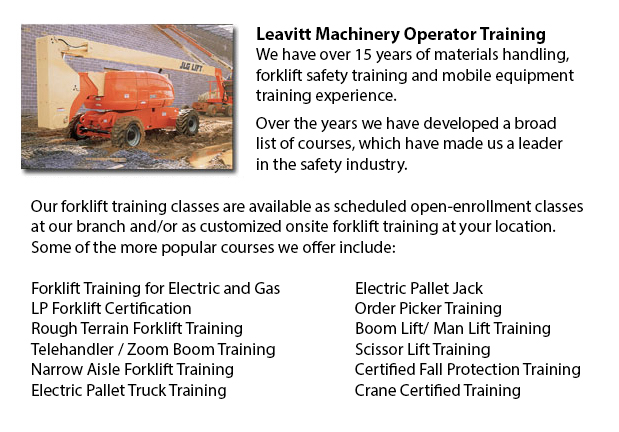
Aerial Platform Training Edmonton - Aerial jacks can accommodate many tasks involving high and tricky reaching places. Normally used to perform routine repair in structures with lofty ceilings, prune tree branches, hoist heavy shelving units or patch up phone cables. A ladder could also be used for many of the aforementioned tasks, although aerial hoists provide more safety and strength when correctly used.
There are a few different versions of aerial forklifts existing, each being capable of performing moderately different jobs. Painters will sometimes use a scissor lift platform, which is able to be used to reach the 2nd story of buildings. The scissor aerial platform lifts use criss-cross braces to stretch and lengthen upwards. There is a platform attached to the top of the braces that rises simultaneously as the criss-cross braces raise.
Bucket trucks and cherry pickers are a different variety of aerial hoist. They possess a bucket platform on top of an extended arm. As this arm unfolds, the attached platform rises. Platform lifts use a pronged arm that rises upwards as the lever is moved. Boom lifts have a hydraulic arm that extends outward and hoists the platform. Every one of these aerial lifts have need of special training to operate.
Training programs presented through Occupational Safety & Health Association, acknowledged also as OSHA, deal with safety steps, machine operation, maintenance and inspection and device load capacities. Successful completion of these education courses earns a special certified license. Only properly certified individuals who have OSHA operating licenses should operate aerial hoists. The Occupational Safety & Health Organization has developed rules to uphold safety and prevent injury when utilizing aerial platform lifts. Common sense rules such as not utilizing this machine to give rides and making sure all tires on aerial hoists are braced in order to prevent machine tipping are observed within the guidelines.
Sadly, figures illustrate that more than 20 operators die each year when running aerial platform lifts and 8% of those are commercial painters. Most of these incidents are due to inadequate tire bracing and the lift falling over; therefore a lot of of these deaths had been preventable. Operators should make certain that all wheels are locked and braces as a critical safety precaution to prevent the instrument from toppling over.
Additional guidelines include marking the surrounding area of the device in an obvious way to protect passers-by and to guarantee they do not come too close to the operating machine. It is crucial to ensure that there are also 10 feet of clearance between any power cables and the aerial hoist. Operators of this equipment are also highly recommended to always have on the proper security harness when up in the air.
-
Forklift Training Programs Edmonton
Forklift Training Programs Edmonton - If you are searching for work as an operator of a forklift, our regulatory-compliant lift truck training programs provide excellent instruction in numerous styles and types of forklifts, classes on pre-shift insp... More -
Heavy Equipment Training School Edmonton
Heavy Equipment Training School Edmonton - The heavy equipment operator courses will assist the operator in acquiring the required skills and knowledge they will require to be able to enter the workforce as an entry level operator. In this 12 week co... More -
Manlift Ticket Edmonton
Manlift Ticket Edmonton - The Elevated Platforms and Manlifts Certification program helps to provide the necessary training on the safe operating procedures, work practice, rules and regulations regarding the daily activities for the operators of thi... More -
Crane License Edmonton
Crane License Edmonton - Crane operators must be "credentialed", which means they must have a crane operator license or certification. Credentialing is considered a mandatory governmental requirement in order to practice as a crane operator. Having a... More -
Counterbalance Forklift License Edmonton
Counterbalance Forklift License Edmonton - When operated by totally trained operators, forklifts could become a major advantage for firms and companies. We could offer your staff a comprehensive training program which covers all aspects of operating... More -
Manlift Safety Training Edmonton
Manlift Safety Training Edmonton - Manlift operators have to be aware and cognizant of all the potential hazards which are associated with particular types of scissor lifts. They need to be able to operate the scissor lift in a way that protects not... More -
Forklift Training School Edmonton
Forklift Training School Edmonton - Forklift Training School And Reasons Why It Is Really Important - Industry and federal regulators have established the criteria for forklift safety training based on their existing standards and regulations. Indivi... More -
Overhead Crane Safety Training Edmonton
Overhead Crane Safety Training Edmonton - The overhead crane safety training course is designed to equip the operators with the right skills and knowledge in the areas of: crane safety precautions, materials handling, accident avoidance, and equipmen... More

Forklift Training Edmonton
crossorigin="anonymous">
TOLL FREE: 1-888-254-6157
Edmonton, Alberta
forklifttrainingedmonton.com
Email Us
About Us


